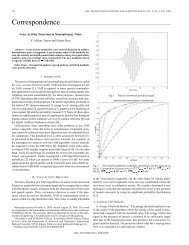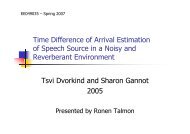Thesis (PDF) - Signal & Image Processing Lab
Thesis (PDF) - Signal & Image Processing Lab
Thesis (PDF) - Signal & Image Processing Lab
Create successful ePaper yourself
Turn your PDF publications into a flip-book with our unique Google optimized e-Paper software.
3.2. TOPOGRAPHIC DISTANCE TREE IMPLEMENTATION 39<br />
to the topographic-distance) of a previously processed flat zone. The new flat zone<br />
then becomes a new node of the TD-Tree, linked as a son to the latter flat zone.<br />
Its topographic-distance-function value is computed as that of the father plus the<br />
topographic-distance between them.<br />
A pseudo code of the modified Moore algorithm is given in Algorithm 1.<br />
Algorithm 1 Modified Moore Algorithm<br />
We modified algorithm of Moore, for topographic distance calculation, using definition<br />
(2.18) of cost. Our modified algorithm is used not only for topographic distance<br />
calculation, but also for TD-Tree building.<br />
The algorithm, involves the following stages:<br />
1: Assign zero to the topographic distance of the root node of the TD-Tree, and, to<br />
the other nodes, assign an infinite topographic distance.<br />
2: Initialize status vector of all flat zones to status ”in-queue”.<br />
3: while not all nodes are ”done” do<br />
4: Find the node with the minimal topographic distance.<br />
5: Based on this minimal topographic distance, calculate the topographic distance<br />
of the neighboring nodes, whose status are ”in-queue”, using the<br />
graph structure. Store the node with the minimal topographic distance as<br />
a father node of these neighboring nodes in the TD-Tree.<br />
6: In the status vector, assign status ”done” to the node with minimal topographic<br />
distance.<br />
7: end while<br />
The proposed representation is more efficient in storing the information about<br />
alternating sequences than storing an alternating sequence for every flat zone. The<br />
storage volume required for the alternating sequence for every flat zone depends on<br />
the number of flat zones multiplied by the mean alternating sequence length. Size =<br />
O(N · Length(AS)) � O(N 2 ), where N is a number of flat zones. Typical values of<br />
N is in order of 10 4 for small images, and in order of 10 5 for larger images. When the<br />
same information is presented as a tree, the required storage volume depends on the<br />
number of flat zones multiplied by the size of the pointer to the father node, which is<br />
much smaller than the average size of an alternate sequence. In this case the required<br />
storage volume is linear to N: Size � O(N).
















